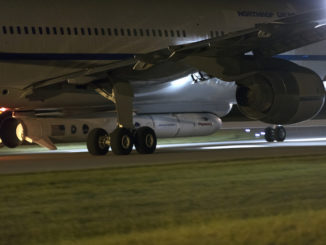First static fire test of a Falcon Heavy center core completed at our McGregor, TX rocket development facility last week. pic.twitter.com/tHUHc1QiKG
— SpaceX (@SpaceX) May 9, 2017
The center section of SpaceX’s first Falcon Heavy rocket has been test-fired at the launch company’s test facility in Central Texas, a sign of progress toward the behemoth booster’s long-delayed maiden mission scheduled some time in the final months of 2017.
The core stage is a modified version of the first stage that powers SpaceX’s Falcon 9 rocket. Engineers added structural supports and attach points for the Falcon Heavy’s side boosters, which are also based on the Falcon 9 first stage.
The first Falcon Heavy mission will launch with a newly-manufactured core stage and two previously-flown side boosters, each with aerodynamic nose caps.
SpaceX has test-fired one of the reused boosters in McGregor, Texas, after refurbishment following a launch in May 2016 with a Thaicom communications satellite. Once hotfire testing of the core stage is complete, workers will raise another previously-flown side booster for a static firing.
Each of the boosters for the maiden Falcon Heavy mission will be shipped to NASA’s Kennedy Space Center in Florida for final processing in the coming months. The powerful rocket, which will generate 5.1 million pounds of thrust from its 27 main engines, will blast off from launch pad 39A on its inaugural test flight.
Another hold-down firing with all 27 Merlin engines is planned at pad 39A in the days before the test launch.
Like the Falcon 9, the Falcon Heavy will fly with a single-engine second stage and stand nearly 230 feet (70 meters) tall.

But the triple-body rocket will be able to loft payloads three times heavier to orbit than the Falcon 9. According to figures published by SpaceX and United Launch Alliance, the Falcon Heavy has more than twice the capacity to low Earth orbit than ULA’s Delta 4-Heavy, another three-core launcher that is currently the most powerful rocket in the world.
The Falcon Heavy’s path to the sky has been bumpy, with numerous delays since SpaceX founder and CEO Elon Musk unveiled the heavy-lifter at the National Press Club in Washington in 2011. At the time, Musk predicted the Falcon Heavy would make its first launch in 2013.
“Falcon Heavy is one of those things that, at first, sounded easy,” Musk said in March. “We’ll just take two first stages and use them as strap-on boosters. Actually, no, this is crazy hard, and it required the redesign of the center core and a ton of different hardware.
“It was actually shockingly difficult to go from a single-core to a triple-core vehicle,” Musk said.
He said the first Falcon Heavy launch was scheduled for “late summer” during a meeting with reports March 30.
SpaceX aims to land the Falcon Heavy’s two side boosters on solid ground at Cape Canaveral following the launch, while the center core will continue downrange, targeting touchdown on a recovery vessel in the Atlantic Ocean.
Another hurdle SpaceX must clear in the coming months is the reactivation of pad 40 at Cape Canaveral, which was significantly damaged in September 2016 by a rocket explosion. The blast forced SpaceX to relocate all its East Coast launches to nearby pad 39A at Kennedy Space Center.
SpaceX is repairing pad 40 in hopes of shifting launches back there later this year, then crews can finish upgrades to pad 39A to accommodate the Falcon Heavy.
SpaceX needs the Falcon Heavy to satisfy the needs of its most demanding customers, such as the U.S. Air Force and the National Reconnaissance Office, to place large payloads into orbit. The Falcon Heavy will also send robotic “Red Dragon” capsules on unpiloted test flights to Mars beginning as soon as 2020, pathfinders for SpaceX’s long-term vision to send humans there.
Email the author.
Follow Stephen Clark on Twitter: @StephenClark1.



